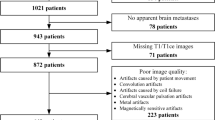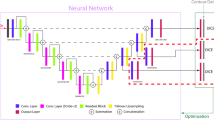Abstract
Objectives
To construct and evaluate a gated high-resolution convolutional neural network for detecting and segmenting brain metastasis (BM).
Methods
This retrospective study included craniocerebral MRI scans of 1392 patients with 14,542 BMs and 200 patients with no BM between January 2012 and April 2022. A primary dataset including 1000 cases with 11,686 BMs was employed to construct the model, while an independent dataset including 100 cases with 1069 BMs from other hospitals was used to examine the generalizability. The potential of the model for clinical use was also evaluated by comparing its performance in BM detection and segmentation to that of radiologists, and comparing radiologists’ lesion detecting performances with and without model assistance.
Results
Our model yielded a recall of 0.88, a dice similarity coefficient (DSC) of 0.90, a positive predictive value (PPV) of 0.93 and a false positives per patient (FP) of 1.01 in the test set, and a recall of 0.85, a DSC of 0.89, a PPV of 0.93, and a FP of 1.07 in dataset from other hospitals. With the model’s assistance, the BM detection rates of 4 radiologists improved significantly, ranging from 5.2 to 15.1% (all p < 0.001), and also for detecting small BMs with diameter ≤ 5 mm (ranging from 7.2 to 27.0%, all p < 0.001).
Conclusions
The proposed model enables accurate BM detection and segmentation with higher sensitivity and less time consumption, showing the potential to augment radiologists’ performance in detecting BM.
Clinical relevance statement
This study offers a promising computer-aided tool to assist the brain metastasis detection and segmentation in routine clinical practice for cancer patients.
Key Points
• The GHR-CNN could accurately detect and segment BM on contrast-enhanced 3D-T1W images.
• The GHR-CNN improved the BM detection rate of radiologists, including the detection of small lesions.
• The GHR-CNN enabled automated segmentation of BM in a very short time.






Similar content being viewed by others

Abbreviations
- BM:
-
Brain metastasis
- CAD:
-
Computer-assisted diagnosis
- CNN:
-
Convolutional neural network
- DL:
-
Deep learning
- DSC:
-
Dice similarity coefficient
- GHR-CNN:
-
Gated high-resolution convolutional neural network
- ML:
-
Machine learning
- PPV:
-
Positive predictive value
- SRT:
-
Stereotactic radiotherapy
References
Owonikoko TK, Arbiser J, Zelnak A et al (2014) Current approaches to the treatment of metastatic brain tumours. Nat Rev Clin Oncol 11:203–222
Suh JH, Kotecha R, Chao ST, Ahluwalia MS, Sahgal A, Chang EL (2020) Current approaches to the management of brain metastases. Nat Rev Clin Oncol 17:279–299
Carden CP, Agarwal R, Saran F, Judson IR (2008) Eligibility of patients with brain metastases for phase I trials: time for a rethink? Lancet Oncol 9:1012–1017
Olson JJ, Kalkanis SN, Ryken TC (2019) Congress of Neurological Surgeons Systematic Review and Evidence-Based Guidelines for the Treatment of Adults With Metastatic Brain Tumors: Executive Summary. Neurosurgery 84:550–552
Pope WB (2018) Brain metastases: neuroimaging. Handb Clin Neurol 149:89–112
National Comprehensive Cancer Network. NCCN Clinical Practice Guidelines in Oncology. Available via https://www.nccn.org/professionals/physician_gls/. Accessed 1 Jun 2020
Lin NU, Lee EQ, Aoyama H et al (2015) Response assessment criteria for brain metastases: proposal from the RANO group. Lancet Oncol 16:e270–278
Schellinger PD, Meinck HM, Thron A (1999) Diagnostic accuracy of MRI compared to CCT in patients with brain metastases. J Neurooncol 44:275–281
Yin S, Luo X, Yang Y et al (2022) Development and validation of a deep-learning model for detecting brain metastases on 3D post-contrast MRI: a multi-center multi-reader evaluation study. Neuro Oncol 24:1559–1570
Zhang M, Young GS, Chen H et al (2020) Deep-learning detection of cancer metastases to the brain on MRI. J Magn Reson Imaging 52:1227–1236
Growcott S, Dembrey T, Patel R, Eaton D, Cameron A (2020) Inter-observer variability in target volume delineations of benign and metastatic brain tumours for stereotactic radiosurgery: results of a national quality assurance programme. Clin Oncol (R Coll Radiol) 32:13–25
Gudigar A, Raghavendra U, Hegde A, Kalyani M, Ciaccio EJ, Rajendra Acharya U (2020) Brain pathology identification using computer aided diagnostic tool: a systematic review. Comput Methods Programs Biomed 187:105205
Titano JJ, Badgeley M, Schefflein J et al (2018) Automated deep-neural-network surveillance of cranial images for acute neurologic events. Nat Med 24:1337–1341
Yang J, Xie M, Hu C et al (2021) Deep learning for detecting cerebral aneurysms with CT angiography. Radiology 298:155–163
Larson DB, Chen MC, Lungren MP, Halabi SS, Stence NV, Langlotz CP (2018) Performance of a deep-learning neural network model in assessing skeletal maturity on pediatric hand radiographs. Radiology 287:313–322
Zheng Q, Yang L, Zeng B et al (2021) Artificial intelligence performance in detecting tumor metastasis from medical radiology imaging: a systematic review and meta-analysis. EClinicalMedicine 31:100669
Sunwoo L, Kim YJ, Choi SH et al (2017) Computer-aided detection of brain metastasis on 3D MR imaging: Observer performance study. PLoS One 12:e0178265
Shi Z, Miao C, Schoepf UJ et al (2020) A clinically applicable deep-learning model for detecting intracranial aneurysm in computed tomography angiography images. Nat Commun 11:6090
Bousabarah K, Ruge M, Brand JS et al (2020) Deep convolutional neural networks for automated segmentation of brain metastases trained on clinical data. Radiat Oncol 15:87
Cao Y, Vassantachart A, Ye JC et al (2021) Automatic detection and segmentation of multiple brain metastases on magnetic resonance image using asymmetric UNet architecture. Phys Med Biol 66:015003
Charron O, Lallement A, Jarnet D, Noblet V, Clavier JB, Meyer P (2018) Automatic detection and segmentation of brain metastases on multimodal MR images with a deep convolutional neural network. Comput Biol Med 95:43–54
Cho J, Kim YJ, Sunwoo L et al (2021) Deep learning-based computer-aided detection system for automated treatment response assessment of brain metastases on 3D MRI. Front Oncol 11:739639
Dikici E, Ryu JL, Demirer M et al (2020) Automated brain metastases detection framework for T1-weighted contrast-enhanced 3D MRI. IEEE J Biomed Health Inform 24:2883–2893
Deike-Hofmann K, Dancs D, Paech D et al (2021) Pre-examinations improve automated metastases detection on cranial MRI. Invest Radiol 56:320–327
Grøvik E, Yi D, Iv M, Tong E, Rubin D, Zaharchuk G (2020) Deep learning enables automatic detection and segmentation of brain metastases on multisequence MRI. J Magn Reson Imaging 51:175–182
Jünger ST, Hoyer UCI, Schaufler D et al (2021) Fully Automated MR detection and segmentation of brain metastases in non-small cell lung cancer using deep learning. J Magn Reson Imaging 54:1608–1622
Kikuchi Y, Togao O, Kikuchi K et al (2022) A deep convolutional neural network-based automatic detection of brain metastases with and without blood vessel suppression. Eur Radiol 32:2998–3005
Liu Y, Stojadinovic S, Hrycushko B et al (2017) A deep convolutional neural network-based automatic delineation strategy for multiple brain metastases stereotactic radiosurgery. PLoS One 12:e0185844
Losch M (2015) Detection and segmentation of brain metastases with deep convolutional networks. Master’s Thesis, KTH Royal Institute of Technology in Stockholm.
Park YW, Jun Y, Lee Y et al (2021) Robust performance of deep learning for automatic detection and segmentation of brain metastases using three-dimensional black-blood and three-dimensional gradient echo imaging. Eur Radiol 31:6686–6695
Pennig L, Shahzad R, Caldeira L et al (2021) Automated detection and segmentation of brain metastases in malignant melanoma: evaluation of a dedicated deep learning model. AJNR Am J Neuroradiol 42:655–662
Xue J, Wang B, Ming Y et al (2020) Deep learning-based detection and segmentation-assisted management of brain metastases. Neuro Oncol 22:505–514
Yoo SK, Kim TH, Chun J et al (2022) Deep-learning-based automatic detection and segmentation of brain metastases with small volume for stereotactic ablative radiotherapy. Cancers (Basel) 14:2555
Zhou Z, Sanders JW, Johnson JM et al (2020) Computer-aided detection of brain metastases in T1-weighted MRI for stereotactic radiosurgery using deep learning single-shot detectors. Radiology 295:407–415
Yang X, Shi J, Zhang J, Li Q (2022) Gated channel attention mechanism YOLOv3 network for small target detection. Advances in Multimedia 2022:1–10
Isensee F, Petersen J, Kohl SAA, Jäger PF, Maier-Hein KH (2019) nnU-Net: breaking the spell on successful medical image segmentation, arXiv preprint arXiv:1904.08128
Chen C, Liu X, Ding M, Zheng J, Li J (2019) 3D Dilated multi-fiber network for real-time brain tumor segmentation in MRI. in: International Conference on Medical Image Computing and Computer-Assisted Intervention. Springer.2019:184-192
Luo Z, Jia Z, Yuan Z, Peng J (2021) HDC-Net: Hierarchical Decoupled Convolution Network for Brain Tumor Segmentation. IEEE J Biomed Health Inform 25:737–745
Cho SJ, Sunwoo L, Baik SH, Bae YJ, Choi BS, Kim JH (2021) Brain metastasis detection using machine learning: a systematic review and meta-analysis. Neuro Oncol 23:214–225
Farjam R, Parmar HA, Noll DC, Tsien CI, Cao Y (2012) An approach for computer-aided detection of brain metastases in post-Gd T1-W MRI. Magn Reson Imaging 30:824–36
Yang S, Nam Y, Kim MO, Kim EY, Park J, Kim DH (2013) Computer-aided detection of metastatic brain tumors using magnetic resonance black-blood imaging. Invest Radiol 48:113–119
Perez-Ramirez U, Arana E, Moratal D (2016) Brain metastases detection on MR by means of three-dimensional tumor-appearance template matching. J Magn Reson Imaging 44:642–652
James CA, Wachter RM, Woolliscroft JO (2022) Preparing clinicians for a clinical world influenced by artificial intelligence. JAMA 327:1333–1334
Kumawat S, Verma M, Nakashima Y, Raman S (2021) Depthwise spatio-temporal STFT convolutional neural networks for human action recognition. IEEE Trans Pattern Anal Mach Intell 44:4839–4851
Funding
This work was supported by National Key R&D Program of China (Project Nos. 2022YFC2009901, 2022YFC2009900), the National Natural Science Foundation of China (Grant Nos. 82120108014, 82071908 and 82101998), CAMS Innovation Fund for Medical Sciences (CIFMS) (Project No. 2021-I2M-C&T-A-022), Chengdu Science and Technology Office, major technology application demonstration project (Project Nos. 2022-YF09-00062-SN, 2022-GH03-00017-HZ) and Sichuan Science and Technology Program (Grant Nos. 2021JDTD0002). Dr. Su Lui acknowledges the support from Humboldt Foundation Friedrich Wilhelm Bessel Research Award and Chang Jiang Scholars (Program No. T2019069).
Author information
Authors and Affiliations
Corresponding author
Ethics declarations
Guarantor
The scientific guarantor of this publication is Professor Su Lui, MD, PhD, from Department of Radiology, West China Hospital, Sichuan University.
Conflict of interest
The authors have no relevant conflicts of interest to disclose.
Statistics and biometry
No complex statistical methods were necessary for this paper.
Informed consent
The institutional review board waived the requirement to obtain informed patient consent for this retrospective study.
Ethical approval
Institutional Review Board approval was obtained.
Methodology
• retrospective
• diagnostic or prognostic study
• performed at multiple institutions
Additional information
Publisher's note
Springer Nature remains neutral with regard to jurisdictional claims in published maps and institutional affiliations.
Supplementary Information
Below is the link to the electronic supplementary material.
Rights and permissions
Springer Nature or its licensor (e.g. a society or other partner) holds exclusive rights to this article under a publishing agreement with the author(s) or other rightsholder(s); author self-archiving of the accepted manuscript version of this article is solely governed by the terms of such publishing agreement and applicable law.
About this article
Cite this article
Qu, J., Zhang, W., Shu, X. et al. Construction and evaluation of a gated high-resolution neural network for automatic brain metastasis detection and segmentation. Eur Radiol 33, 6648–6658 (2023). https://doi.org/10.1007/s00330-023-09648-3
Received:
Revised:
Accepted:
Published:
Issue Date:
DOI: https://doi.org/10.1007/s00330-023-09648-3



